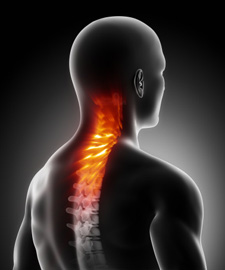Muscle Spasms and the “C” Curve in my Neck – Are They Connected?
 A knotted muscle does not cause your neck to lose its curve
A knotted muscle does not cause your neck to lose its curve
Your neck has a natural curve – the bones in your neck, the cervical vertebrae, aren’t supposed to run in a straight up and down stack. They fit together in a curve, a “C” curve.
People who have lost this natural alignment are more prone to suffer from chronic pain in their neck, upper back and shoulders, and often live with poorer overall health.
In our Chiropractic practice, x-ray evidence is a primary tool. But it’s always interesting to see how some patients choose to interpret what they see. When confronted with an x-ray that shows loss of their neck’s natural curve, some patients will assert it’s only due to a tight or cramped muscle.
A pill won’t fix the problem
“If I go home and take a muscle relaxant, my neck will be fine,” they say. “It will go back to normal.”
Unfortunately, correcting a misaligned spine/neck is not that easy. If they go home, take the pills, even get a massage, the picture would not change should we retake the same X-ray.
Muscle tension does not cause this problem. It’s a structural, not functional issue rooted in the ligaments – the bones’ connective tissue.
How does it come about? Any number of ways – an old injury, such as whiplash from a car accident, or years of desk work, aggravated by poor ergonomics. It’s often just the wear and tear of everyday life, no different than developing knee problems or carpal tunnel syndrome.
But don’t just take our word for it.
The proof is in the study
A recent study published in the peer-reviewed Journal of Radiology Case Reports investigated whether hypertonicity, or tension of the muscles, as seen in muscle spasms, can have a significant impact on cervical lordosis – your neck’s natural “C” curve.
In short, the answer was no.
This study, “Impact of Isometric Contraction of Anterior Cervical Muscles on Cervical Lordosis,” took 29 volunteers and randomly subjected them to induced muscle spasms. This created a state of hypertonicity that could be measured to determine its impact on the neck’s curve. No, it doesn’t sound pleasant, but these brave souls did volunteer to do their part for science. This was the first study of its kind to use objective measurements and statistical data.
Challenging conventional thinking
The authors found no evidence that muscle spasms contributed to the loss of the neck’s natural curve. But this conclusion flies in the face of conventional thinking:
“The results of this study are in direct conflict with over 50 years of radiographic reports, physiological texts and articles stating that the loss or reversing of the cervical lordosis are caused by cervical muscles spasms,” their report reads.
In addition, the authors also concluded what we already knew – the loss of your neck’s natural curve is a progressive condition that can “create a cascade of weakened cervical ligaments and discs.” The result is more pain and more of that unhealthy head forward posture. This leads to irreversible arthritic degeneration, which we have ample proof of in our patient x-rays.
This degeneration can be stopped in its tracks with the right corrective intervention – if applied early enough. Allow it to progress too far and there is little we can do for you.
The moral of this story?
While a pill can offer temporary relief to help you get through the day, it only masks the symptom of a deeper problem. It’s a Band-Aid, not a long term solution. You need a consistent program of structural correction to put your spine back where it belongs.
